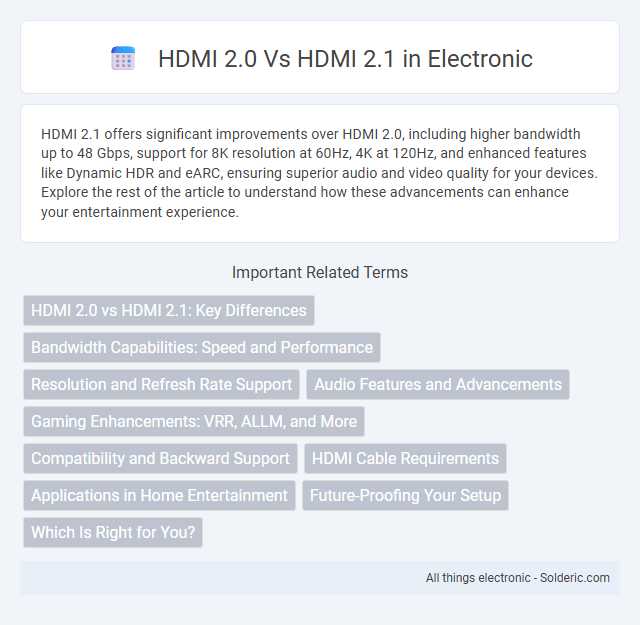HDMI 2.1 offers significant improvements over HDMI 2.0, including higher bandwidth up to 48 Gbps, support for 8K resolution at 60Hz, 4K at 120Hz, and enhanced features like Dynamic HDR and eARC, ensuring superior audio and video quality for your devices. Explore the rest of the article to understand how these advancements can enhance your entertainment experience.
Comparison Table
| Feature | HDMI 2.0 | HDMI 2.1 |
|---|---|---|
| Maximum Bandwidth | 18 Gbps | 48 Gbps |
| Maximum Resolution | 4K @ 60Hz | 10K @ 120Hz |
| HDR Support | HDR10 | Dynamic HDR, HDR10+, Dolby Vision |
| Refresh Rate | Up to 60Hz | Up to 120Hz (4K), 60Hz (8K) |
| eARC (Enhanced Audio Return Channel) | No | Yes |
| Variable Refresh Rate (VRR) | No | Yes |
| Quick Media Switching (QMS) | No | Yes |
| Quick Frame Transport (QFT) | No | Yes |
| Backward Compatibility | Yes | Yes |
HDMI 2.0 vs HDMI 2.1: Key Differences
HDMI 2.1 supports higher bandwidth up to 48 Gbps compared to HDMI 2.0's 18 Gbps, enabling 4K resolution at 120Hz and 8K at 60Hz, while HDMI 2.0 maxes out at 4K 60Hz. Enhanced features in HDMI 2.1 include Dynamic HDR, eARC for advanced audio support, and Variable Refresh Rate (VRR) for smoother gaming experiences. HDMI 2.1 also improves support for advanced color spaces and higher frame rates, making it essential for next-generation gaming consoles and high-end home theater systems.
Bandwidth Capabilities: Speed and Performance
HDMI 2.0 supports a maximum bandwidth of 18 Gbps, enabling 4K resolution at 60Hz with 8-bit color depth, while HDMI 2.1 significantly increases bandwidth capacity to 48 Gbps, allowing for 4K at 120Hz and 8K at 60Hz with 10-bit color depth and HDR support. The enhanced speed and performance of HDMI 2.1 improve video quality, reduce latency, and support dynamic HDR formats, making it ideal for advanced gaming and high-resolution media playback. This substantial upgrade in data transfer rate enables smoother frame rates, wider color gamuts, and more immersive audiovisual experiences.
Resolution and Refresh Rate Support
HDMI 2.1 significantly enhances resolution and refresh rate support compared to HDMI 2.0, enabling up to 10K resolution and refresh rates up to 120Hz at 4K, whereas HDMI 2.0 maxes out at 4K resolution with 60Hz refresh rate. This upgrade allows your devices to deliver smoother motion and more detailed images, particularly beneficial for gaming and high-end video playback. Choosing HDMI 2.1 ensures compatibility with future-proof displays and the highest quality visual performance.
Audio Features and Advancements
HDMI 2.1 significantly enhances audio capabilities by supporting eARC (Enhanced Audio Return Channel), which allows for high-bitrate audio formats like Dolby Atmos and DTS:X to be transmitted seamlessly from your TV to sound systems. In contrast, HDMI 2.0 supports standard ARC, limiting the audio quality and bandwidth for immersive sound experiences. These advancements in HDMI 2.1 ensure superior audio performance and compatibility with the latest home theater setups.
Gaming Enhancements: VRR, ALLM, and More
HDMI 2.1 significantly enhances gaming with features like Variable Refresh Rate (VRR) and Auto Low Latency Mode (ALLM), reducing screen tearing and input lag for smoother gameplay. VRR dynamically matches the display's refresh rate to the gaming console or PC frame rate, delivering ultra-fluid visuals, while ALLM automatically switches the display to low latency mode when gaming is detected. Compared to HDMI 2.0, which lacks these advanced gaming enhancements, HDMI 2.1 provides a more responsive and immersive gaming experience.
Compatibility and Backward Support
HDMI 2.1 maintains full backward compatibility with HDMI 2.0 devices, allowing seamless connection between newer TVs and older sources or vice versa. HDMI 2.0 supports resolutions up to 4K at 60Hz, while HDMI 2.1 enhances this capability with 4K at 120Hz and 8K at 60Hz, requiring compatible cables like Ultra High Speed HDMI for optimal performance. Devices with HDMI 2.1 ports automatically negotiate the highest supported standard, ensuring interoperability without loss of functionality across generations.
HDMI Cable Requirements
HDMI 2.0 supports up to 18 Gbps bandwidth, enabling 4K resolution at 60Hz with standard High-Speed HDMI cables, while HDMI 2.1 demands Ultra High-Speed HDMI cables to handle up to 48 Gbps bandwidth for 4K at 120Hz and 8K at 60Hz. Ultra High-Speed HDMI cables feature enhanced shielding and improved transmission quality, ensuring compatibility with advanced features like Dynamic HDR and eARC. Choosing the correct HDMI cable is critical to fully leverage the capabilities of HDMI 2.1 devices.
Applications in Home Entertainment
HDMI 2.1 significantly enhances home entertainment by supporting 8K resolution at 60Hz and 4K at 120Hz, enabling ultra-high-definition content and smoother motion for gaming and streaming. Features like Dynamic HDR and enhanced Audio Return Channel (eARC) improve visual quality and audio fidelity, creating an immersive viewing experience. HDMI 2.0 supports up to 4K at 60Hz, sufficient for standard UHD TVs but lacks the advanced capabilities required for next-generation consoles and high-frame-rate video content.
Future-Proofing Your Setup
HDMI 2.1 offers significant future-proofing advantages over HDMI 2.0, with support for higher resolutions like 8K at 60Hz and 4K at 120Hz, ensuring your setup can handle next-generation content. Enhanced features such as Dynamic HDR, eARC, and variable refresh rates (VRR) in HDMI 2.1 improve your viewing experience and compatibility with evolving devices. Choosing HDMI 2.1 means your home theater or gaming system remains compatible with upcoming technologies, protecting your investment.
Which Is Right for You?
HDMI 2.1 offers significant upgrades over HDMI 2.0, including support for 8K resolution at 60Hz and 4K at 120Hz, enhanced refresh rates with Variable Refresh Rate (VRR), and increased bandwidth of up to 48 Gbps. HDMI 2.0, suitable for most 4K gaming and streaming needs, supports up to 18 Gbps and 4K at 60Hz, making it a cost-effective option for users without high-end display requirements. Your choice depends on whether you need advanced features like 8K video, higher frame rates, or future-proof connectivity for next-gen gaming consoles and home theater setups.
HDMI 2.0 vs HDMI 2.1 Infographic

 solderic.com
solderic.com